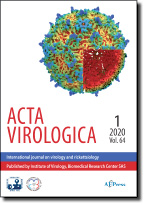Journal info
|
||
Select Journal
Journals
Bratislava Medical Journal Endocrine Regulations General Physiology and Biophysics Neoplasma Acta Virologica Current articles 2023 2022 2021 2020 2019 2018 2017 2016 2015 2014 2013 2012 2011 2010 2009 2008 2007 2006 2005 2004 2003 Studia Psychologica Cardiology Letters Psychológia a patopsych. dieťaťa Kovove Materialy-Metallic Materials Slovenská hudbaWebshop Cart
Your Cart is currently empty.
Info: Your browser does not accept cookies. To put products into your cart and purchase them you need to enable cookies.
Acta Virologica Vol.60, No.1, p.41-48, 2016 |
||
| Title: Accumulation of a soluble form of human nectin-2 is required for exerting the resistance against herpes simplex virus type 2 infection in transfected cells | ||
| Author: Y. FUJIMOTO, K. OZAKI, N. IWAMORI, H. TAKAKUWA, E. ONO | ||
| Abstract: Cell entry of herpes simplex virus type 2 (HSV-2) requires the interaction of viral glycoprotein D (gD) with the receptor nectin-1 and herpesvirus entry mediator (HVEM). In addition, it is known that nectin-2 is also functional as a receptor for HSV-2, although the binding to the gD is weak. To examine an antiviral potential of a soluble form of human nectin-2 (hNectin-2Ig), transfected Vero cells expressing the entire ectodomain of nectin-2 fused to the Fc portion of human IgG were established. Specific binding of hNectin-2Ig to HSV-2 gD was confirmed by ELISA. Competitive ELISA demonstrated that accumulation of hNectin-2Ig in transfected cells increased significantly in a cell culture time dependent manner. Viral growth of several HSV-2 strains was significantly inhibited in the transfected cells that were cultured for 72 hr compared with control Vero cells, but not in cells that were cultured for 24 hr. These results indicate that accumulation of a soluble form of nectin-2 is required for exerting the resistance against HSV-2 infection. |
||
| Keywords: antiviral effect; soluble form of nectin-2; herpes simplex virus type 2 | ||
| Published online: 16-Mar-2016 | ||
| Year: 2016, Volume: 60, Issue: 1 | Page From: 41, Page To: 48 | |
| doi:10.4149/av_2016_01_41 |
||
|
|
 download file download file |
|

